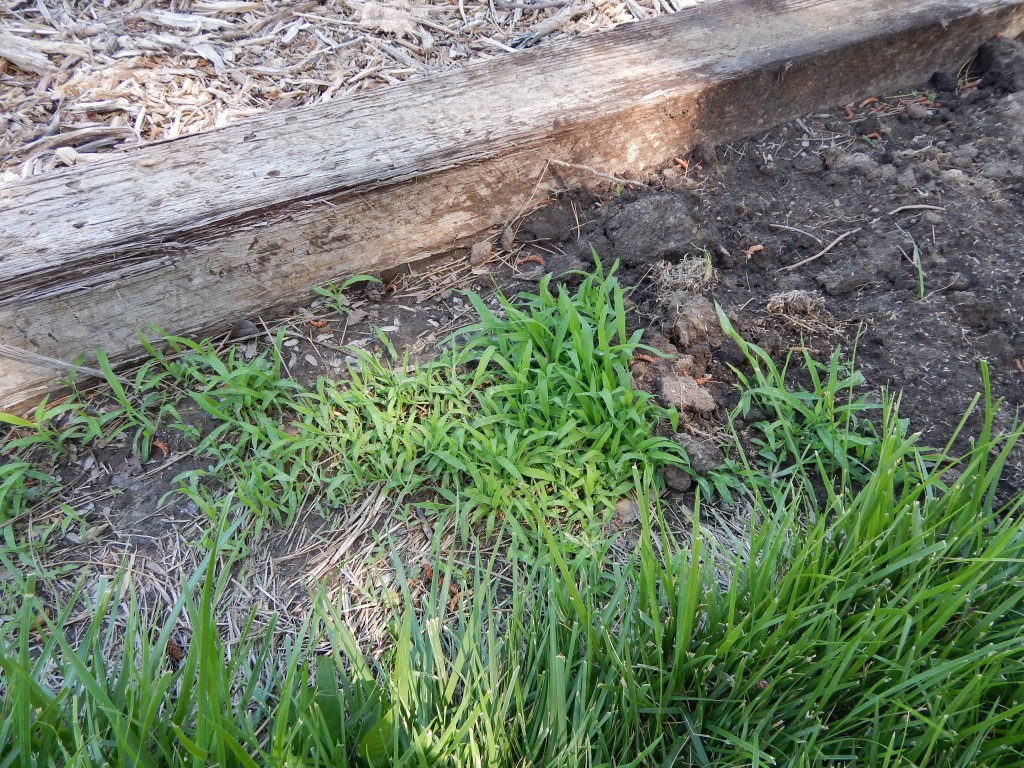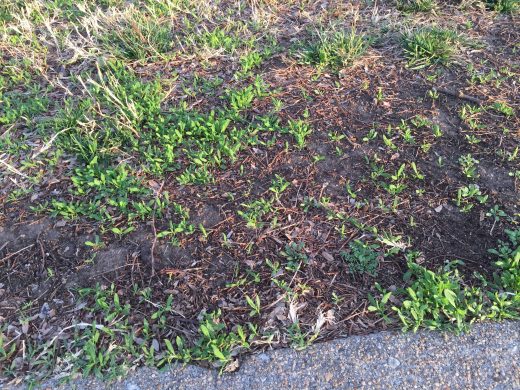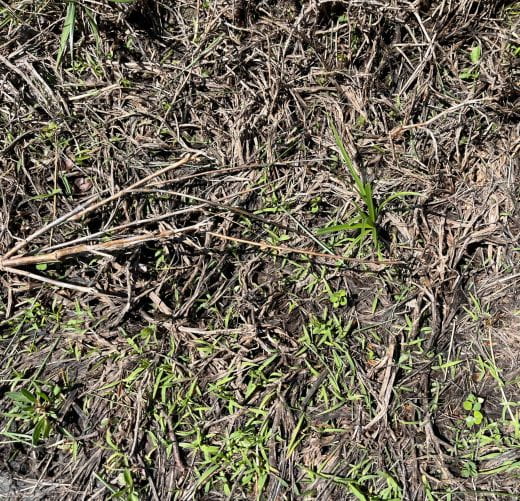 Photo shows crabgrass emerging in Olathe, Kansas near a paved walking path in a park area. Greater soil warmth allows for earlier emergence in these areas. The photo was taken on April 21.
Photo shows crabgrass emerging in Olathe, Kansas near a paved walking path in a park area. Greater soil warmth allows for earlier emergence in these areas. The photo was taken on April 21.
Tag: crabgrass
Enhance Effectiveness of Preemergence Herbicide Application
This blog post was presented last year, but we’re approaching that time of year again when crabgrass and other annual grassy weeds are approaching emergence.

As a reminder, if you want more detailed information on weed control in general, consider getting this 2022 publication that was developed by several state universities, including K-State, and was led by Purdue: “Weed Control for Turfgrass Professionals”
Preemergence herbicide applications for crabgrass, goosegrass, foxtail, and other annual grasses are underway. Here are bullet points to consider to increase the efficacy of the herbicide you use.
Maintain turf density and mow higher. Good turf density resulting from proper cultural practices for the grass you’re managing reduces encroachment of all weeds, including annual grasses. Mowing at the higher end of the recommended range has consistently shown significantly lower populations of crabgrass and other annual grasses than mowing at lower mowing heights.
Apply before emergence. Not all annual grass species emerge at the same time. For example, goosegrass emerges later than crabgrass. However, even within a species, emergence of new seedlings occurs throughout spring and summer. With most preemergence herbicides, when seedlings have emerged, they will not effectively control those plants. However, the application will control emergence of grasses beyond that date. Dithiopyr (Dimension) does provide control of crabgrass that has emerged but has not begun to produce tillers.
Use effective strategies to guide application. Calendar dates, soil temperature, flowering of ornamentals, and other strategies are all used to help guide applications and maximize herbicide residual during the period annual grasses emerge. Here are a few articles related to this subject:
How Preemergence Herbicides Work and Why They Fail (Univ. of Nebraska)
https://blogs.k-state.edu/turf/methods-of-predicting-crabgrass-emergence/
https://blogs.k-state.edu/turf/flowering-ornamentals-and-crabgrass-emergence/
Apply uniformly. Uniform application is critical – just like distributing paint evenly over your house is aesthetically pleasing. If you leave a section of the house unpainted, it’s clearly visible. Good annual grass control requires uniform application; if an area is not treated, it’s likely you’ll seed weed emergence there. Uniform application is achieved by proper spreader or sprayer calibration, colorants that indicate areas that have been treated with liquid products, and applying the product in two directions (half rate in each).
Split applications. Some, not all, preemergence herbicides generally provide better suppression of annual grasses when applications are split (1/2 rate each application), usually 6 to 8 weeks apart. This allows a higher level of herbicide presence on the soil surface, which will minimize weed emergence. Here’s an article from Purdue on this subject:
https://turf.purdue.edu/wp-content/uploads/2012/06/15_AGRY_Patton_sequential20apps.pdf
Water in after application. For preemergence herbicides to be activated and ensure uniform distribution on the soil surface, irrigation (or rainfall) after application is needed.
Find more information on weed control by clicking on the tags on the blog (left column), such as “weed control,” “crabgrass,” etc., or search by category on the right side of the page.
***Mention of trade names or commercial products in this article is solely for identification purposes and does not imply recommendation or endorsement, nor is criticism implied of similar products not mentioned by Kansas State University.***
Don’t forget to follow the K-State Turf and Landscape Team on Twitter @KSUTURF
Also, visit our facebook page www.facebook.com/KSUTurf
Tips for Enhancing Efficacy of Preemergence Herbicides
By Dr. Jack Fry
Preemergence herbicide applications for crabgrass, goosegrass, foxtail, and other annual grasses are underway. Here are some bullet points to consider to increase the efficacy of the herbicide you use.
Maintain turf density and mow higher. Good turf density resulting from proper cultural practices for the grass you’re managing reduces encroachment of all weeds, including annual grasses. Mowing at the higher end of the recommended range has consistently shown significantly lower populations of crabgrass and other annual grasses than mowing at lower mowing heights.
Apply before emergence. Not all annual grass species emerge at the same time. For example, goosegrass emerges later than crabgrass. However, even within a species, emergence of new seedlings occurs throughout spring and summer. With most preemergence herbicides, when seedlings have emerged, they will not effectively control those plants. However, the application will control emergence of grasses beyond that date. Dithiopyr (Dimension) does provide control of crabgrass that has emerged but has not begun to produce tillers.
Use effective strategies to guide application. Calendar dates, soil temperature, flowering of ornamentals, and other strategies are all used to help guide applications and maximize herbicide residual during the period annual grasses emerge. Here are a couple of articles related to this subject:
https://blogs.k-state.edu/turf/methods-of-predicting-crabgrass-emergence/
https://blogs.k-state.edu/turf/flowering-ornamentals-and-crabgrass-emergence/
Apply uniformly. Uniform application is critical – just like distributing paint evenly over your house is aesthetically pleasing. If you leave a section of the house unpainted, it’s clearly visible. Good annual grass control requires uniform application; if an area is not treated, it’s likely you’ll seed weed emergence there. Uniform application is achieved by proper spreader or sprayer calibration, colorants that indicate areas that have been treated with liquid products, and applying the product in two directions (half rate in each).
Split applications. Preemergence herbicides generally provide better suppression of annual grasses when applications are split (1/2 rate each application), usually 6 to 8 weeks apart. This allows a higher level of herbicide presence on the soil surface, which will minimize weed emergence. Here’s an article from Purdue on this subject:
https://turf.purdue.edu/wp-content/uploads/2012/06/15_AGRY_Patton_sequential20apps.pdf
Water in after application. For preemergence herbicides to be activated and ensure uniform distribution on the soil surface, irrigation (or rainfall) after application is needed.
Find more information on weed control by clicking on the tags on the blog (left column), such as “weed control,” “crabgrass,” etc., or search by category on the right side of the page.
***Mention of trade names or commercial products in this article is solely for identification purposes and does not imply recommendation or endorsement, nor is criticism implied of similar products not mentioned by Kansas State University.***
Don’t forget to follow the K-State Turf and Landscape Team on Twitter @KSUTurf
Also, visit our facebook page www.facebook.com/KSUTurf
Consider Postemergence Crabgrass Control When Plants are Young (Now)
By Dr. Jack Fry
Crabgrass is now becoming quite visible. If you didn’t apply a preemergence herbicide, or had some crabgrass emerge even where it was applied, now is the time to consider postemergence control. If a preemergence herbicide was applied, but you’re still seeing crabgrass, there may have been variability in uniformity of delivery over the area to which it was applied. If new sod was laid recently, it’s common for crabgrass to emerge through the seams. Control is easier when plants are young, for they are rapidly growing and have a thinner leaf cuticle. Make sure the crabgrass plant isn’t under stress before you apply the herbicide; rainfall or irrigation on the area within a few days prior to application can help ensure the herbicide is absorbed and translocated. Dr. Hoyle wrote a nice summary of best approaches to postemergence crabgrass control here: https://blogs.k-state.edu/turf/postemergent-crabgrass-control
In addition, consider purchasing Turf Weed Control for Professionals, which was developed by cooperatively by numerous universities in the Midwest, including K-State. It can be purchased as a hard copy or a PDF download here: https://mdc.itap.purdue.edu/item.asp?Item_Number=TURF-100
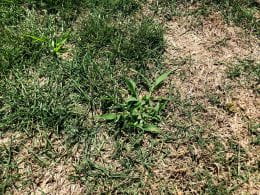
Crabgrass Has Emerged
By Dr. Jack Fry
Crabgrass emergence was evident last weekend – at least in Olathe, KS (picture below).

Crabgrass seedlings (inside white border) emerging on April 19, 2020 in Olathe, KS.
This was on bare soil next to a paved sidewalk. It can take a few weeks longer for crabgrass to emerge within areas of thin turf due to cooler soil temperatures (see article on timing herbicide applications here: Flowering Ornamentals and Crabgrass Emergence). So, on a lawn of acceptable quality (and no bare areas), you should still have time to get a preemergence herbicide out. Once you see crabgrass such as this emerging within a lawn, consider using a preemergence herbicide that has postemergence activity, such as dithiopyr (Dimension) or mesotrione (Tenacity). Of course, there are also a number of postemergence herbicides that can be used for crabgrass control as well.
Always remember to READ THE LABEL for the correct rate, turfgrass tolerance, and specific instructions before application!!!
***Mention of trade names or commercial products in this article is solely for identification purposes and does not imply recommendation or endorsement, nor is criticism implied of similar products not mentioned by Kansas State University.***
K-State turfgrass specialist urges mid-summer checkup on lawns
Many Kansas landscapes include warm-season grasses, which require a little care in order to stay healthy during the hot summer months.
Hoyle says warm-season grasses may need fertilizer to remain healthy
MANHATTAN, Kan. – Kansas State University Associate Professor and Extension Turfgrass Specialist, Dr. Jared Hoyle says homeowners ought to be thinking about a mid-summer checkup on their lawns, which likely includes applying fertilizer and weed killer.
Many Kansas summer landscapes include warm-season grasses, namely bermudagrass, zoysiagrass and buffalograss. Each of those requires a little care in order to stay healthy through the hot weeks ahead.
“Those three grasses are not all created equal and some grow faster than others, which means we need to feed them a little bit different,” said Hoyle, an associate professor in the Department of Horticulture and Natural Resources.
For bermudagrass and zoysiagrass, Hoyle suggests applying a total of 1-3 pounds of nitrogen per 1000 square feet during a typical growing season, which is the beginning of May through the middle of August.
“You can split that up into multiple applications of a quick release fertilizer, or you could do fewer applications of a slower release,” he said. “But the main goal is 1-3 pounds of nitrogen per 1000 square feet regardless of what number or percentage product you’re using.”
Buffalograss does not require as much nitrogen. Studies at Kansas State University indicate that “about 1 pound of nitrogen per year for 1000 square feet is good,” according to Hoyle.
“It’s hard to split up a pound over multiple applications, so that’s one where you might want to look at a slow release to put that pound of nitrogen per 1000 square feet throughout the year,” he said. “You can do that right now and that will get you through the rest of the year with a slow release fertilizer.”
In addition to fertilizing warm-season grasses, Hoyle said homeowners should be looking at ways to control thatch and weeds in the lawn.
“We really like to preach that if you are going to do something with the lawn — whether it is fertilizing or watering — do it when it’s actively growing,” Hoyle said. “Right now, with warm-season grasses, if you have a thatch problem, you can tear that area up (with a verti-cutter or slicer), fertilize the lawn, and it will grow right back in. If you try to do that during the fall or spring months, there will be periods of time when the lawn isn’t growing, or delayed growth, and it could lead to more problems.”
Among weeds, crabgrass and yellow nutsedge are two of the most troublesome this time of year.
““I’m seeing a lot of crabgrass and yellow nutsedge and I blame it on the weather,” Hoyle said. “Yellow nutsedge loves flooded, compacted soils and because of periodic flooding around the state, I have seen a lot of areas that typically never have yellow nutsedge. It’s a weed to keep an eye out with the weather conditions as they have been.”
To control yellow nutsedge, look for products with the active ingredients halosulfuron or sulfrentrazone, he said.
Crabgrass that has already emerged can be treated with products that include the active ingredient quinclorac.
Hoyle noted that homeowners should be patient when applying herbicides to yellow nutsedge and crabgrass; it might take more than one application to control those weeds.
K-State’s Department of Horticulture and Natural Resources publishes a weekly horticulture newsletter with updated information on lawn care and other turfgrass issues. Residents may also contact their local extension agent.
Under Attack from Weeds
(By Jared Hoyle, KSU Turfgrass Research and Extension)
As a turfgrass manager, as soon as you think you have it under control… BAM, you are under attack. Just in a short period of time Manhattan has been under attack from weeds. Now many of these weeds are large and hard to control.
With all the rain earlier in the season there was standing water in many of the low areas of the research farm. The turf did not like it and eventually died. But what did like it was yellow nutsedge. I put up some information about this in the recent past but, it is everywhere and I am still getting phone calls about it so I wanted to direct you to the most recent post on controlling yellow nutsedge.
https://blogs.k-state.edu/turf/yellow-nutsedge-reported-across-ks/
Also, you can use glyphosate to treat yellow nutsedge in landscape beds but it only provides marginal control. Remember not to use glyphosate to treat yellow nutsedge in your turf.
Crabgrass galore! Slow to start but it is going strong now! Anywhere we didn’t put down a preemergent herbicide this year crabgrass has started to take over. Good thing there is options for control. Check out my earlier post for crabgrass options. Pay attention to control options for larger tillered crabgrass.
https://blogs.k-state.edu/turf/postemergent-crabgrass-control-2/
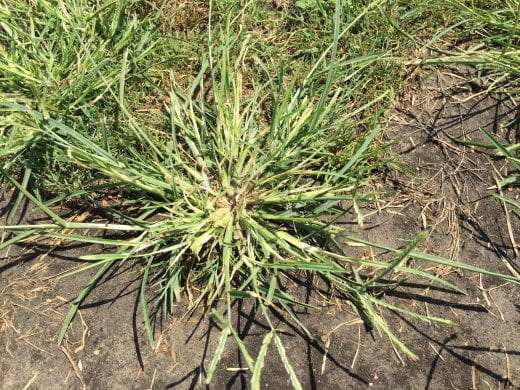
If it is not yellow nutsedge or crabgrass it is goosegrass. Back in early June, goosegrass emergence was reported across Kansas. Now the goosegrass is growing and going to be more difficult to control because it has tillered out. Make sure you make your follow-up applications when recommended and choose your control options that are effective on larger goosegrass.
If you have cool-season turfgrass then you can use fenoxaprop (Acclaim Extra), fluazifop (Fusilade II), tropramizone (Pylex), or MSMA (golf courses and sod farms only!). You will have to do more than one application since the goosegrass is tillered out. Sulfentrazone (Dismiss) is also effective on goosegrass if it has not tillered out yet so might want to go with another option since now the goosegrass is big.
For all you golf courses out there that have creeping bentgrass fairways it is going to be a little bit more difficult because the herbicides that work best tend to injure the turf. 1-Tiller or smaller can be controlled with fenoxaprop (Acclaim Extra) at 3.5 fl oz/A but you will need to re-apply every two weeks to make sure you are applying to small plants. This could be a follow-up option if new goosegrass starts to emerge before the season it over.
As crazy as it sounds a herbicide that has commonly been used for broadleaf weeds has shown control on goosegrass. SpeedZone (2,4-D +dicamba + MCPP) has shown control but a follow up application is going to be needed 30 days after initial application. Pay attention to the temperature restrictions in this heat!
Tropramizone (Pylex) can be used on bentgrass at lower rates (0.25 fl oz/A) but definitely need a repeat application at 21 days
Now if you have bermudagrass or zoysiagrass then you can use Tribute TOTAL (thiencarbazone + foramsulfuron + halosulfuron). Fusilade II and Acclaim Extra that works in cool-season grass can also be used on zoysiagrass. If you mix these products with triclopyr (Turflon Ester Ultra or Triclopyr 4) then you will get better results.
Always remember to READ THE LABEL for the correct rate, turfgrass tolerance, and specific instructions before application!!!
Information in this article is from Turfgrass Weed Control for Professionals.
Patton, A.J., M. Elmore, J. Hoyle, J. Kao-Kniffin, B. Branham, T. Voigt, N. Christians, A. Thoms, G. Munshaw, A. Hathaway, T. Nikolai, B. Horgan, L. Miller, X. Xiong, W. Kreuser, R. Gaussoin, D. Gardner, Z. Raudenbush, D. Li, P. Landschoot, D. Soldat, and P. Koch. 2019 Turfgrass Weed Control for Professionals. Purdue University Extension Publication. TURF-100. pp. 128.
Get your copy here – https://www.bookstore.ksre.ksu.edu/Item.aspx?catId=545&pubId=20239
***Mention of trade names or commercial products in this article is solely for identification purposes and does not imply recommendation or endorsement, nor is criticism implied of similar products not mentioned by Kansas State University.***
Don’t forget to follow me on twitter @KSUTurf.
Also, visit our facebook page www.facebook.com/KSUTurf
Postemergent Crabgrass Control
(By Jared Hoyle, KSU Turfgrass Research and Extension)
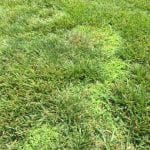 Today I was walking around the Rocky Ford Turfgrass Research Center in Manhattan, KS looking for an area to put out a postemergent crabgrass study and notice that the crabgrass on the research farm is all different stages. It is important to know what stage the crabgrass is in to help with control. That could determine your success in controlling it with postemergent herbicides
Today I was walking around the Rocky Ford Turfgrass Research Center in Manhattan, KS looking for an area to put out a postemergent crabgrass study and notice that the crabgrass on the research farm is all different stages. It is important to know what stage the crabgrass is in to help with control. That could determine your success in controlling it with postemergent herbicides
There are postemergent herbicide options out there for crabgrass control. But depending on how big or how many tillers the crabgrass has will help you determine what product to use. First, determine the size or stage of crabgrass you have present.
Here is a picture to show the tillering stages of crabgrass.
The smaller the crabgrass the easier it is to kill it. The tillered crabgrass may take more than one application and higher rates so make sure you check the label for correct application rates and intervals.
- dithopyr – Can provide control to crabgrass up to one tiller stage. This product also has preemergence activity.
- quinclorac – Can be applied on most cool- and warm-season turfgrass species. This product controls crabgrass when it is one tiller or smaller or when it has four or more tillers.
- mesotrione – Can be effective for crabgrass control but in most cases will take two applications at two week intervals. The label also states that applications must be made before the four tiller crabgrass stage.
- topramazone – Similar to mesotrione, this product will require two applications at three week intervals. Use at higher rates on crabgrass that have greater than one tiller.
- fenoxaprop – Are very effective in controlling crabgrass. Label states that this product can be applied to annual grasses up to the five tiller stage. Remember not to tank mix with products that contain 2,4-D, antagonism can occur.
As one last reminder, do not apply post emergent herbicides outside the recommended temperature on the label. This will increase the risk of turfgrass injury.
Always remember to READ THE LABEL for the correct rate, turfgrass tolerance, and specific instructions before application!!!
***Mention of trade names or commercial products in this article is solely for identification purposes and does not imply recommendation or endorsement, nor is criticism implied of similar products not mentioned by Kansas State University.***
Don’t forget to follow me on twitter @KSUTurf.
Also, visit our facebook page www.facebook.com/KSUTurf
Weed Control Update
(By Jared Hoyle, KSU Turfgrass Research and Extension)
As I look back through blog posts from Spring time in previous years, I notice a repeated theme – Crabgrass, Knotweed and Wild Garlic.
So instead of “reinventing the wheel this year” and writing a new blog post I am going to post previous years posts for these weeds. There is lots of great information about these weeds and how to control them. (Links to information below the photograph.)
This way I can focus on adding a weed to this list that is become more and more persistent in Kansas. (Stay tuned!)
Crabgrass
https://blogs.k-state.edu/turf/more-than-you-ever-want-to-know-about-preemergent-herbicides/

Wild Garlic
https://blogs.k-state.edu/turf/stinks-dont-it-wild-garlic-control-in-turfgrass/
Knotweed
https://blogs.k-state.edu/turf/not-your-fathers-knotweed/
Always remember to READ THE LABEL for the correct rate, turfgrass tolerance, and specific instructions before application!!!
***Mention of trade names or commercial products in this article is solely for identification purposes and does not imply recommendation or endorsement, nor is criticism implied of similar products not mentioned by Kansas State University.***
Don’t forget to follow me on twitter @KSUTurf.
Also, visit our facebook page www.facebook.com/KSUTurf
Postemergent Crabgrass Control
(By Jared Hoyle, KSU Turfgrass Research and Extension)
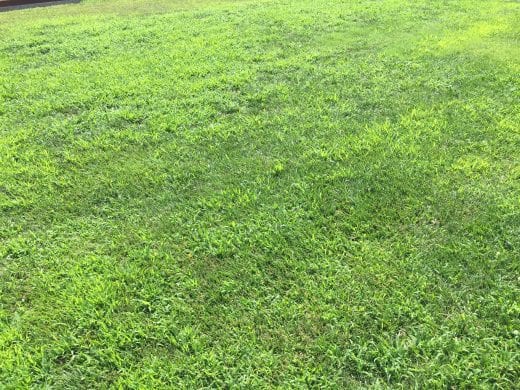 Did you apply a preemergent herbicide this year and still have crabgrass? There are many different reasons you may have break through from a preemergent herbicide application. If the turf is stressed and thin, along with over use of the turf and misapplications are some reasons you may be seeing crabgrass pop-up across many turfgrass areas.
Did you apply a preemergent herbicide this year and still have crabgrass? There are many different reasons you may have break through from a preemergent herbicide application. If the turf is stressed and thin, along with over use of the turf and misapplications are some reasons you may be seeing crabgrass pop-up across many turfgrass areas.
Good news! There are some postemergent herbicide options out there for crabgrass control. But depending on how big or how many tillers the crabgrass has will help you determine what product to use. First, determine the size or stage of crabgrass you have present.
Here is a picture to show the tillering stages of crabgrass.
The smaller the crabgrass the easier it is to kill it. The tillered crabgrass may take more than one application and higher rates so make sure you check the label for correct application rates and intervals.
- dithopyr – Can provide control to crabgrass up to one tiller stage. This product also has preemergence activity.
- quinclorac – Can be applied on most cool- and warm-season turfgrass species. This product controls crabgrass when it is one tiller or smaller or when it has four or more tillers.
- mesotrione – Can be effective for crabgrass control but in most cases will take two applications at two week intervals. The label also states that applications must be made before the four tiller crabgrass stage.
- topramazone – Similar to mesotrione, this product will require two applications at three week intervals. Use at higher rates on crabgrass that have greater than one tiller.
- fenoxaprop – Are very effective in controlling crabgrass. Label states that this product can be applied to annual grasses up to the five tiller stage. Remember not to tank mix with products that contain 2,4-D, antagonism can occur.
As one last reminder, do not apply post emergent herbicides when temperatures are greater than 85 deg F. This will increase the risk of turfgrass injury.
Always remember to READ THE LABEL for the correct rate, turfgrass tolerance, and specific instructions before application!!!
***Mention of trade names or commercial products in this article is solely for identification purposes and does not imply recommendation or endorsement, nor is criticism implied of similar products not mentioned by Kansas State University.***
Don’t forget to follow me on twitter @KSUTurf.
Also, visit our facebook page www.facebook.com/KSUTurf




